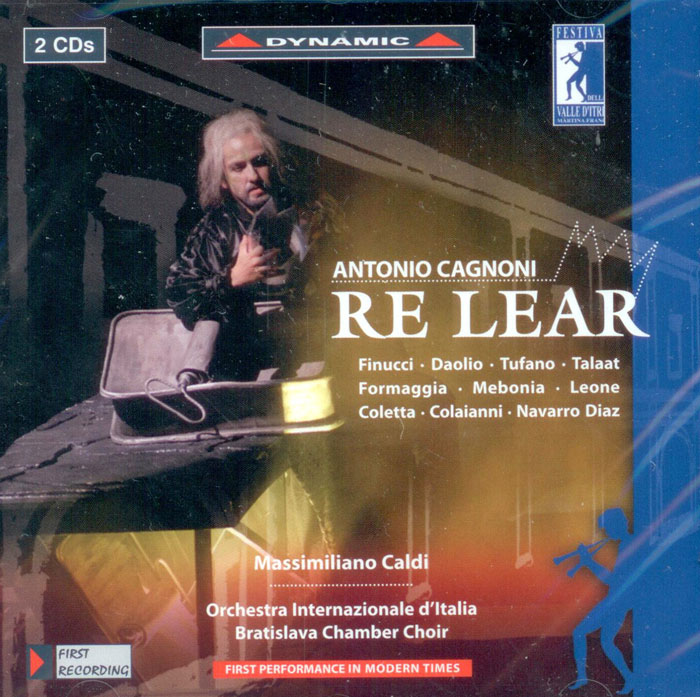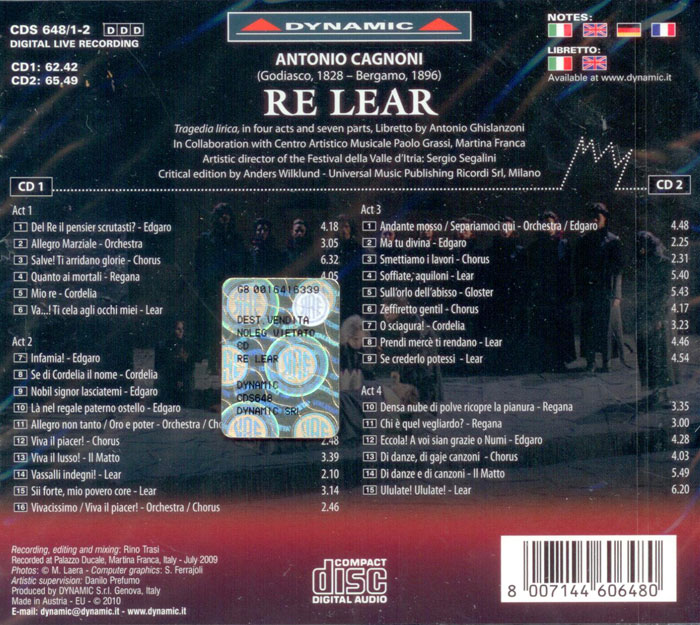Logowanie
Dlaczego wszystkjie inne nie brzmią tak jak te?
Chai Lang, Fan Tao, Broadcasting Chinese Orchestra
Illusive Butterfly
Butterly - motyl - to sekret i tajemnica muzyki chińskiej.
SpeakersCorner - OSTATNIE!!!!
RAVEL, DEBUSSY, Paul Paray, Detroit Symphony Orchestra
Prelude a l'Apres-midi d'un faune / Petite Suite / Valses nobles et sentimentales / Le Tombeau de Couperin
Samozapłon gwarantowany - Himalaje sztuki audiofilskiej
PROKOFIEV, Stanislaw Skrowaczewski, Minneapolis Symphony Orchestra
Romeo and Juliet
Stanisław Skrowaczewski,
✟ 22-02-2017
BARTOK, Antal Dorati, Philharmonia Hungarica
Dance Suite / Two Portraits / Two Excerpts From 'Mikrokosmos'
Samozapłon gwarantowany - Himalaje sztuki audiofilskiej
ENESCU, LISZT, Antal Dorati, The London Symphony Orchestra
Two Roumanian Rhapsodies / Hungarian Rhapsody Nos. 2 & 3
Samozapłon gwarantowany - Himalaje sztuki audiofilskiej
Winylowy niezbędnik
ClearAudio
Cartridge Alignment Gauge - uniwersalny przyrząd do ustawiania geometrii wkładki i ramienia
Jedyny na rynku, tak wszechstronny i właściwy do każdego typu gramofonu!
ClearAudio
Harmo-nicer - nie tylko mata gramofonowa
Najlepsze rozwiązania leżą tuż obok
IDEALNA MATA ANTYPOŚLIZGOWA I ANTYWIBRACYJNA.
Wzorcowe
Carmen Gomes
Celebrating the art and spirit of music - vol. 5 - Reference Songs
- CHCECIE TO WIERZCIE, CHCECIE - NIE WIERZCIE, ALE TO NIE JEST ZŁUDZENIE!!!
Petra Rosa, Eddie C.
Celebrating the art and spirit of music - vol. 3 - Pure
warm sophisticated voice...
SAMPLER - STS DIGITAL, Gregor Hamilton
Celebrating the art and spirit of music - vol. 2 - Love songs from Gregor Hamilton
...jak opanować serca bicie?...
SAMPLER - STS DIGITAL
Celebrating the art and spirit of music - vol. 1 - Leonardo Amuedo
Największy romans sopranu z głębokim basem... wiosennym
Lils Mackintosh
Celebrating the art and spirit of music - vol. 4 - A Tribute to Billie Holiday
Uczennica godna swej Mistrzyni
CAGNONI, Constantino Finucci, Serena Daolio, Orchestra Internationale d'Italia, Massimiliano Caldi
Re Lear

- Disc: 1
- 1. Re Lear, opera: Act 1. Del Re il pensier scrutasti? - Edgaro Listen
- 2. Re Lear, opera: Act 1. Allegro Marziale Listen
- 3. Re Lear, opera: Act 1. Salve! Ti arridano glorie Listen
- 4. Re Lear, opera: Act 1. Quanto ai mortali Listen
- 5. Re Lear, opera: Act 1. Mio re Listen
- 6. Re Lear, opera: Act 1. Va...! Ti cela agli occhi miei Listen
- 7. Re Lear, opera: Act 2. Infamia! Listen
- 8. Re Lear, opera: Act 2. Se di Cordelia il nome Listen
- 9. Re Lear, opera: Act 2. Nobil signor lasciatemi Listen
- 10. Re Lear, opera: Act 2. Là nel regale paterno ostello Listen
- 11. Re Lear, opera: Act 2. Allegro non tanto / Oro e poter Listen
- 12. Re Lear, opera: Act 2. Viva il piacer! Listen
- 13. Re Lear, opera: Act 2. Viva il lusso! Listen
- 14. Re Lear, opera: Act 2. Vassalli indegni! Listen
- 15. Re Lear, opera: Act 2. Sil forte, mio povero core Listen
- 16. Re Lear, opera: Act 2. Vivaccisimo / Viva il piacer! Listen
- Disc: 2
- 1. Re Lear, opera: Act 3. Andante mosso / Separiamoci qui Listen
- 2. Re Lear, opera: Act 3. Ma tu divina Listen
- 3. Re Lear, opera: Act 3. Smettiamo i lavori Listen
- 4. Re Lear, opera: Act 3. Soffiate, aquiloni Listen
- 5. Re Lear, opera: Act 3. Sull'orlo dell'abisso Listen
- 6. Re Lear, opera: Act 3. Zeffiretto gentil Listen
- 7. Re Lear, opera: Act 3. O sciagura! Listen
- 8. Re Lear, opera: Act 3. Prendi, mercè ti rendano Listen
- 9. Re Lear, opera: Act 3. Se crederlo potessi Listen
- 10. Re Lear, opera: Act 4. Densa nube di polve ricopre la pianura Listen
- 11. Re Lear, opera: Act 4. Chi è quel vegliardo? Listen
- 12. Re Lear, opera: Act 4. Eccola! A voi sian grazie o Numi Listen
- 13. Re Lear, opera: Act 4. Di danze e di canzoni Listen
- 14. Re Lear, opera: Act 4. Ululate! Ululate!
- Constantino Finucci - tenor
- Serena Daolio - soprano
- Orchestra Internationale d'Italia - orchestra
- Massimiliano Caldi - conductor
- CAGNONI
King Lear is a tragedy by William Shakespeare, believed to have been written between 1603 and 1606. It is considered one of his greatest works. The play is based on the legend of Leir of Britain, a mythological pre-Roman Celtic king. Re Lear à l'italienne by Sergio Segalini (Artistic director of the Martina Franca Festival) After the unexpected, triumphant success achieved in 2008 with Don Bucefalo it was time to unveil another chapter in the artistic career of the highly unknown Antonio Cagnoni, ill treated in all Music Histories, reviled in dictionaries, branded as "minor" and thus forgettable! In the Fifties people did not want to rediscover Verdi's Macbeth or Donizetti's historical operas, and when it was born the prestigious Rossini festival in Pesaro seemed destined to have a short life. The world of music is "ainsi fait"... whatever is new stinks, be it a revived opera or contemporary music. Don Bucefalo is work of the young Cagnoni, quite the opposite of Re Lear, written in his full maturity; the composer was unable to have it staged in a single theatre and died leaving his beloved child in a drawer. Is this a sign of mediocre creativity? Certainly not, if we think of the great Verdi of maturity, adulated from Paris to St Petersburg, from London to Milan, he could not convince a single theatre to stage his Lear. The Martina Franca Festival provided a response to these rejections: in Shakespeare's play the taste of the time saw only a question of power, no love story between a soprano and a tenor. A bit like Macbeth in some ways. But in Macbeth there was the fantastic element of the witches, the scene of the apparitions, an oppressed people and a wicked couple (to cite a famous Donizetti cabaletta)! In brief, all the ingredients of "melodrama" whose aesthetic rules were to reign throughout the nineteenth century. Re Lear was different and just frightening; but not today, for our culture has opened new doors for us and brought us to new shores. Yet we must listen to this final contribution of Cagnoni's not as if it were Un Ballo in Maschera or Il Trovatore, though it is true that the music brings us back to mid-nineteenth century aesthetics, seeming at times to be in contradiction with the demands of the libretto, too modern for its day. This co-habitation, however, is really very intriguing. For some, perhaps, the real limit of this opera is the fact that it treats Shakespeare's original great drama in a somewhat summarising fashion. Cinema took it on in a version directed by the brilliant Grigori Kozintsev using Pasternak's translation in 1949, and Giorgio Strehler's theatre with the unforgettable Tino Carraro. In opera perhaps the Berlioz of Les Troyens could have managed it - not to mention Wagner, who would have made another Wotan of Lear, betrayed by his daughters. We thank Cagnoni for his courage, for his non-conformity, for his desire to explore new worlds, going against a public and press always capable of shouting just "Verdi, fortissimamente Verdi". For once at least we do not wish to make comparisons and treat musicians as though we were talking of Raffaello or Il Perugino, of Flaubert or Balzac, painters, writers who shine with their own brilliance. Like Antonio Cagnoni. The only comparison to be made is with the Don Bucefalo of his youth. There will be no shortage of surprises. Cast Re Lear Constantino Finucci Cordelia Serena Daolio Regana Eufemia Tufano Il Matto Rasha Talaat Edgardo Danilo Formaggia Conte di Gloster Vladimer Mebonia Gonerilla Maria Leone Duke of Cornwall Gianni Coletta The Earl of Kent Domenico Colaianni Edmondo Cristian Camilo Navarro Diaz Conductor Massimiliano Caldi Orchestra Italian International Orchestra Chorus Slovak Chamber Choir Chorus master Pavol Procházka
























